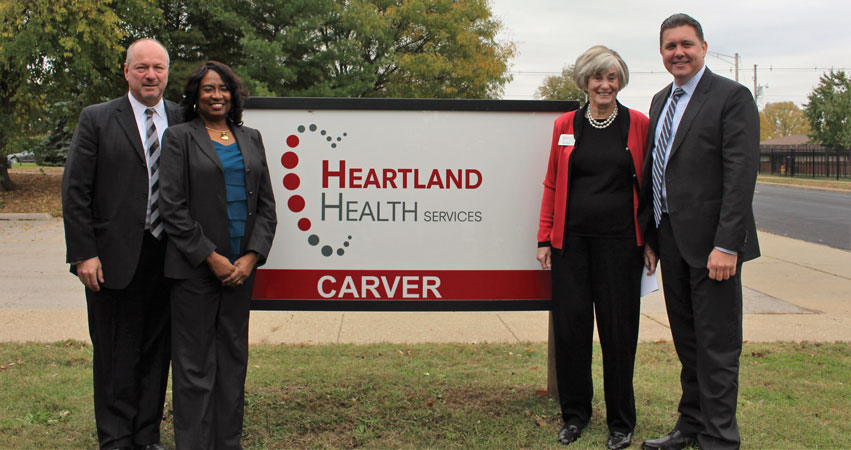
Access to health insurance and healthcare services has dramatically improved individual and community health.
Community health centers serve as the primary medical home for over 25 million people across America. And for more than 25 years, individuals and families in need of medical care have turned to Heartland Health Services (HHS, formerly Heartland Community Health Clinic) to take care of their primary healthcare needs. Serving over 18,000 patients annually in the medically underserved areas of Peoria, Heartland executes the mission of providing high-quality healthcare services accessible to all.
As a Federally Qualified Health Center (FQHC), federal requirements include being located in a medically underserved area, a board of directors with more than half of its members comprised of active patients, and a sliding fee scale for individuals with incomes between 101 and 200 percent of the federal poverty level. According to the U.S. Census Bureau’s 2015 American Community Survey, nearly one third of HHS’ service area (29.1%) received public insurance benefits (Medicaid, Medicare or other public insurance), while 61 percent were covered under private insurance and 9.9 percent remained uninsured.
Social Factors in Healthcare
Social determinants of health are a key factor in an individual’s decision to seek healthcare. According to the 2013 Health Disparities and Inequalities Report from the Centers for Disease Control and Prevention, those who live and work in low socioeconomic circumstances are at increased risk for mortality, morbidity, unhealthy behaviors, reduced access to healthcare and inadequate quality of care.
Heartland recognizes that housing, food and transportation often take precedence over healthcare, and has adapted to meet this community need. Through the outreach and enrollment department, HHS has the ability to arrange transportation to appointments and make the appropriate connections with a range of agencies in the community for other critical needs. Additionally, staff members can assist residents in enrolling for medical benefits such as Medicaid, Medicare and the Marketplace, serving as a resource for all related questions.
For health outcomes, residents of low-income neighborhoods tend to have worse physical and mental health issues compared to higher-income areas, making those with mental health disorders especially vulnerable. Untreated disorders may leave individuals at risk for substance abuse, self-destructive behavior and suicide. It is estimated that 50 percent of Heartland’s patients have some form of mental health disorder—25 percent of them considered severe—yet the Kaiser Family Foundation finds there are only enough psychiatrists to meet the needs of 53 percent of those who need mental health services. Fortunately, Heartland’s relationship with the Human Service Center allows Heartland patients to obtain psychiatry and mental health services. A lack of insurance options, however, could make the healthcare system even more difficult to navigate—and further illustrate that mental health disorders are a significant public health problem.
Access to Services
While health insurance is one of many determinants of health, access to health insurance and healthcare services has been shown to improve individual and population health. Coverage has been shown to reduce psychological distress, increase use of medical services, establish usual sources of care and improve continuity of care—all of which are positively associated with long-term individual health.
In contrast, without a regular source of healthcare services, the uninsured are less likely to receive important preventive services or treatments for chronic conditions such as asthma, diabetes or hypertension—making them more likely to develop severe, yet preventable health conditions and to be diagnosed at more advanced stages of disease. Once diagnosed, the uninsured often receive inadequate medical care and are more likely to experience premature death than those who are insured.
The Impact of Reform
Nationally, there is significant concern among FQHCs regarding the impact health reform may have on services to low-income patients. In 2016, more than 6.4 million people enrolled in marketplace insurance plans, including 247,818 in Illinois. The passage and implementation of the Affordable Care Act has had a significant impact on the rates of uninsured in Peoria County. From 2013 to 2016, these rates declined by 11 percent, and are currently at five percent for Peoria County residents. With the expansion of insurance coverage, Heartland has worked to reform service delivery, increase capacity and improve coordination of care to provide services to this newly insured cohort.
The way these policies are handled in the months and years ahead will have a significant impact not only on the health of the uninsured, but also on the financial health of the healthcare market in Peoria. Whatever the future outcomes from a new administration, Heartland Health Services will remain committed to the well-being of the community, providing care to anyone regardless of insurance status. With the help of community partners like OSF HealthCare and UnityPoint Health, we will continue to work diligently to serve the Peoria area and its most vulnerable populations. iBi
Charles Bandoian is Chief Executive Officer of Heartland Health Services. Learn more at hhsil.com.

